load capacity TOYOTA COROLLA HATCHBACK 2020 Warranties & Maintenance Guides (in English)
[x] Cancel search | Manufacturer: TOYOTA, Model Year: 2020, Model line: COROLLA HATCHBACK, Model: TOYOTA COROLLA HATCHBACK 2020Pages: 260, PDF Size: 8.54 MB
Page 57 of 260

BRIDGESTONE / FIRESTONE
55
Rotation
Follow the vehicle manufacturer’s recommendations, or rotate every
5,000 miles per the recommendations in this manual (see “Radial Tire
Rotation”). In some cases, TPMS devices require reprogramming with
each tire rotation.
RFT Tire Replacement
Do not replace or mix RFT tires with conventional tires, unless on an
emergency/temporary basis. Conventional tires do not have run-flat
capability and the handling characteristics of the vehicle with these
tires may be different. If a conventional tire is used on an emergency/
temporary basis, verify that its size, load capacity, inflation pressure,
and speed rating specifications meet the requirements of the vehicle.
Replace any conventional tire with the proper RFT tire as soon as
possible.
RFT Tire Damage and Repair
No tire, regardless of its design or quality is indestructible. RFT tires
can be ultimately rendered unusable due to a puncture or other road
hazard as well as from improper run-flat or low tire pressure operation.
Some punctures may be repaired under certain restrictions and
prescribed procedures.
When driven flat or with low pressure, factors affecting reparability
include vehicle speed, load, and maneuvering; the amount of inflation
pressure loss; and ambient temperature. In any situation, the extent
and location of direct damage from a puncturing object or other road
hazard are also critical factors.
RFT tires are not repairable in any of the following situations:
•
If the tire was operated with inflation pressure less than 15 psi
(100 kPa).
•
Abrasion or other damage is present on the exterior tread, sidewall
or bead areas.
•
Abrasion, wrinkling, or separation is present on the tire interior.
•
Any condition or damage is present that disqualifies repair of a
conventional tire.
Page 60 of 260
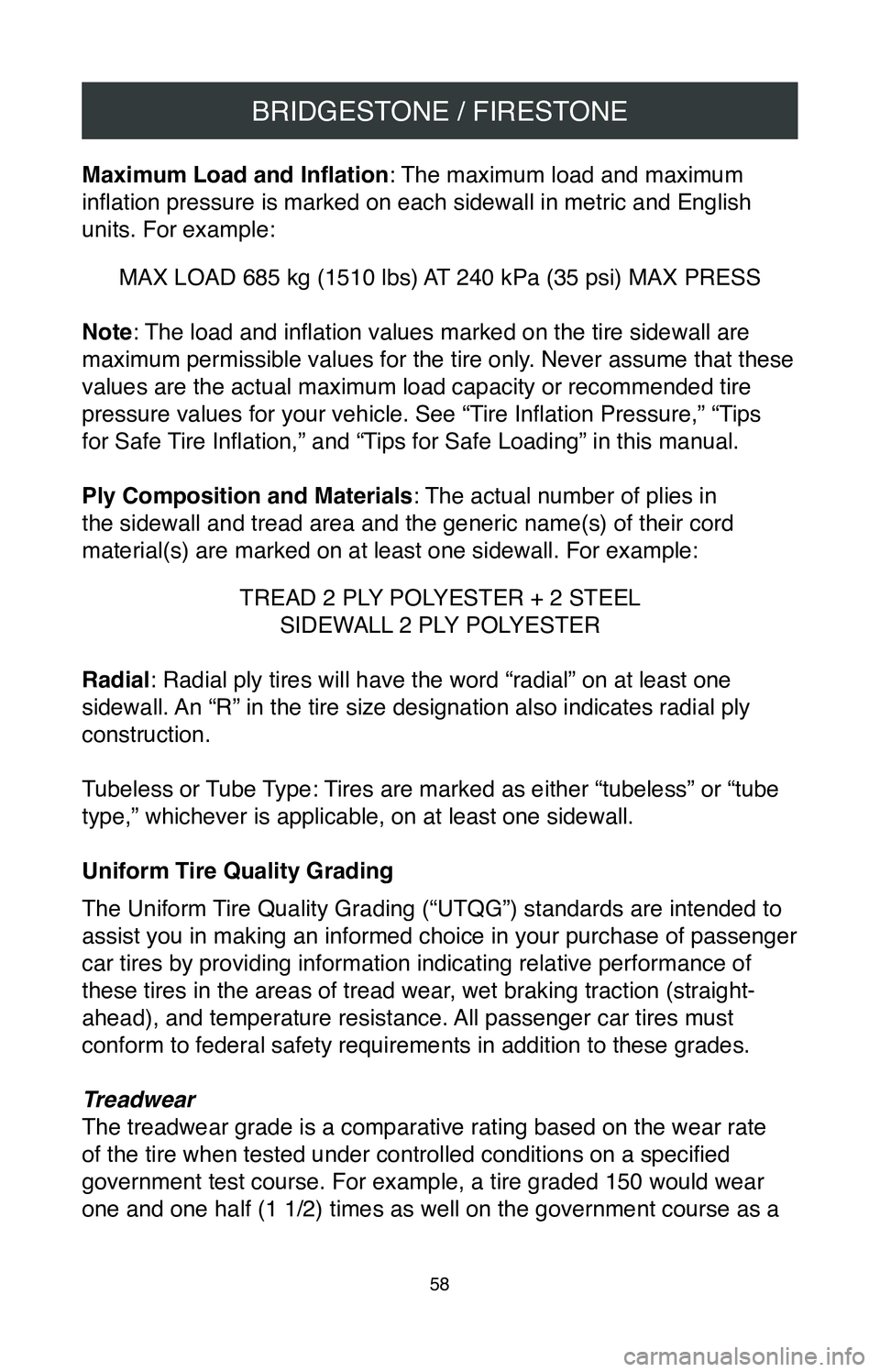
BRIDGESTONE / FIRESTONE
58
Maximum Load and Inflation: The maximum load and maximum
inflation pressure is marked on each sidewall in metric and English
units. For example:
MAX LOAD 685 kg (1510 lbs) AT 240 kPa (35 psi) MAX PRESS
Note: The load and inflation values marked on the tire sidewall are
maximum permissible values for the tire only. Never assume that these
values are the actual maximum load capacity or recommended tire
pressure values for your vehicle. See “Tire Inflation Pressure,” “Tips
for Safe Tire Inflation,” and “Tips for Safe Loading” in this manual.
Ply Composition and Materials : The actual number of plies in
the sidewall and tread area and the generic name(s) of their cord
material(s) are marked on at least one sidewall. For example:
TREAD 2 PLY POLYESTER + 2 STEEL SIDEWALL 2 PLY POLYESTER
Radial: Radial ply tires will have the word “radial” on at least one
sidewall. An “R” in the tire size designation also indicates radial ply
construction.
Tubeless or Tube Type: Tires are marked as either “tubeless” or “tube
type,” whichever is applicable, on at least one sidewall.
Uniform Tire Quality Grading
The Uniform Tire Quality Grading (“UTQG”) standards are intended to
assist you in making an informed choice in your purchase of passenger
car tires by providing information indicating relative performance of
these tires in the areas of tread wear, wet braking traction (straight-
ahead), and temperature resistance. All passenger car tires must
conform to federal safety requirements in addition to these grades.
Treadwear
The treadwear grade is a comparative rating based on the wear rate
of the tire when tested under controlled conditions on a specified
government test course. For example, a tire graded 150 would wear
one and one half (1 1/2) times as well on the government course as a
Page 65 of 260
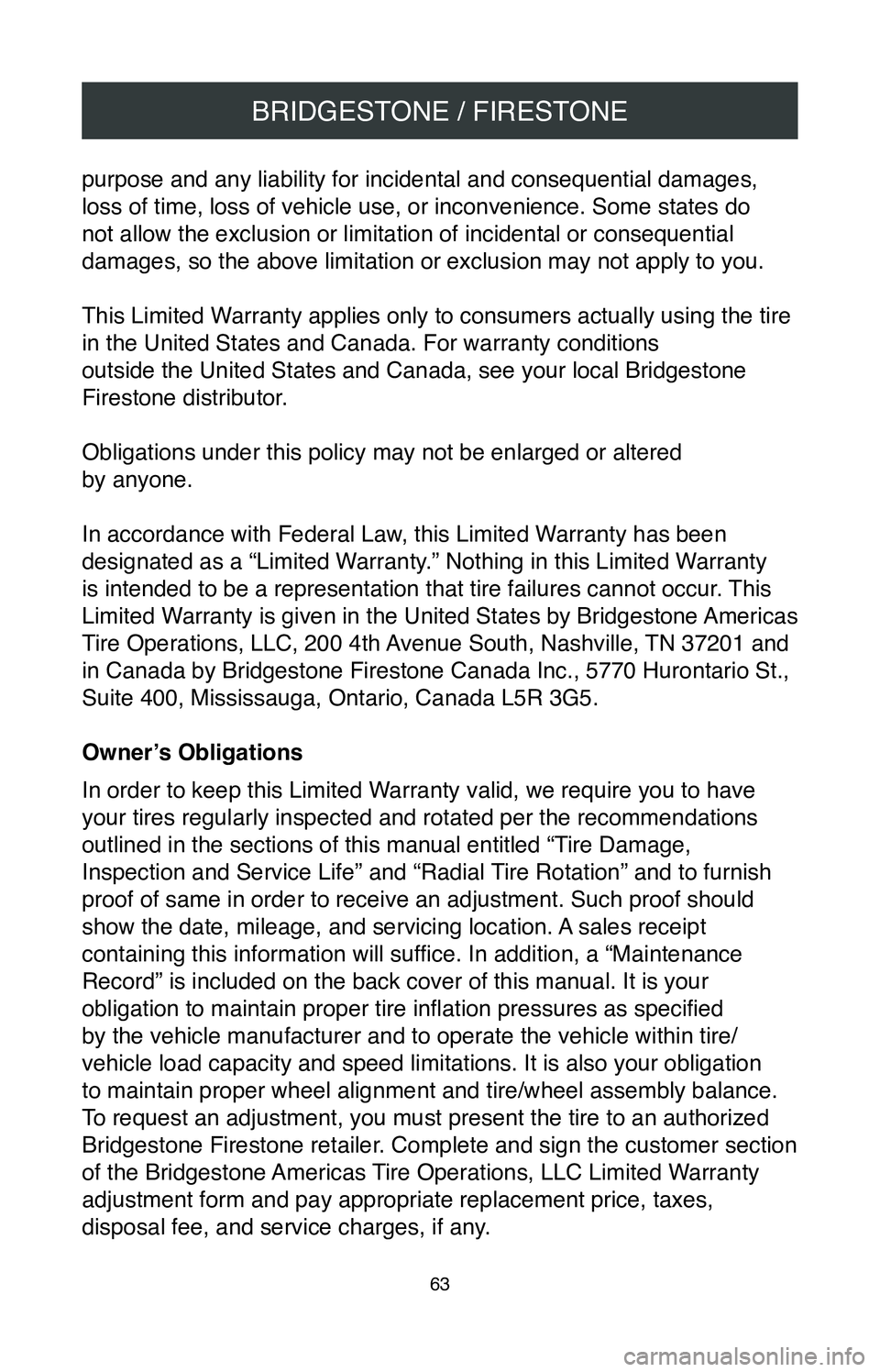
BRIDGESTONE / FIRESTONE
63
purpose and any liability for incidental and consequential damages,
loss of time, loss of vehicle use, or inconvenience. Some states do
not allow the exclusion or limitation of incidental or consequential
damages, so the above limitation or exclusion may not apply to you.
This Limited Warranty applies only to consumers actually using the tire
in the United States and Canada. For warranty conditions
outside the United States and Canada, see your local Bridgestone
Firestone distributor.
Obligations under this policy may not be enlarged or altered
by anyone.
In accordance with Federal Law, this Limited Warranty has been
designated as a “Limited Warranty.” Nothing in this Limited Warranty
is intended to be a representation that tire failures cannot occur. This
Limited Warranty is given in the United States by Bridgestone Americas
Tire Operations, LLC, 200 4th Avenue South, Nashville, TN 37201 and
in Canada by Bridgestone Firestone Canada Inc., 5770 Hurontario St.,
Suite 400, Mississauga, Ontario, Canada L5R 3G5.
Owner’s Obligations
In order to keep this Limited Warranty valid, we require you to have
your tires regularly inspected and rotated per the recommendations
outlined in the sections of this manual entitled “Tire Damage,
Inspection and Service Life” and “Radial Tire Rotation” and to furnish
proof of same in order to receive an adjustment. Such proof should
show the date, mileage, and servicing location. A sales receipt
containing this information will suffice. In addition, a “Maintenance
Record” is included on the back cover of this manual. It is your
obligation to maintain proper tire inflation pressures as specified
by the vehicle manufacturer and to operate the vehicle within tire/
vehicle load capacity and speed limitations. It is also your obligation \
to maintain proper wheel alignment and tire/wheel assembly balance.
To request an adjustment, you must present the tire to an authorized
Bridgestone Firestone retailer. Complete and sign the customer section
of the Bridgestone Americas Tire Operations, LLC Limited Warranty
adjustment form and pay appropriate replacement price, taxes,
disposal fee, and service charges, if any.
Page 117 of 260
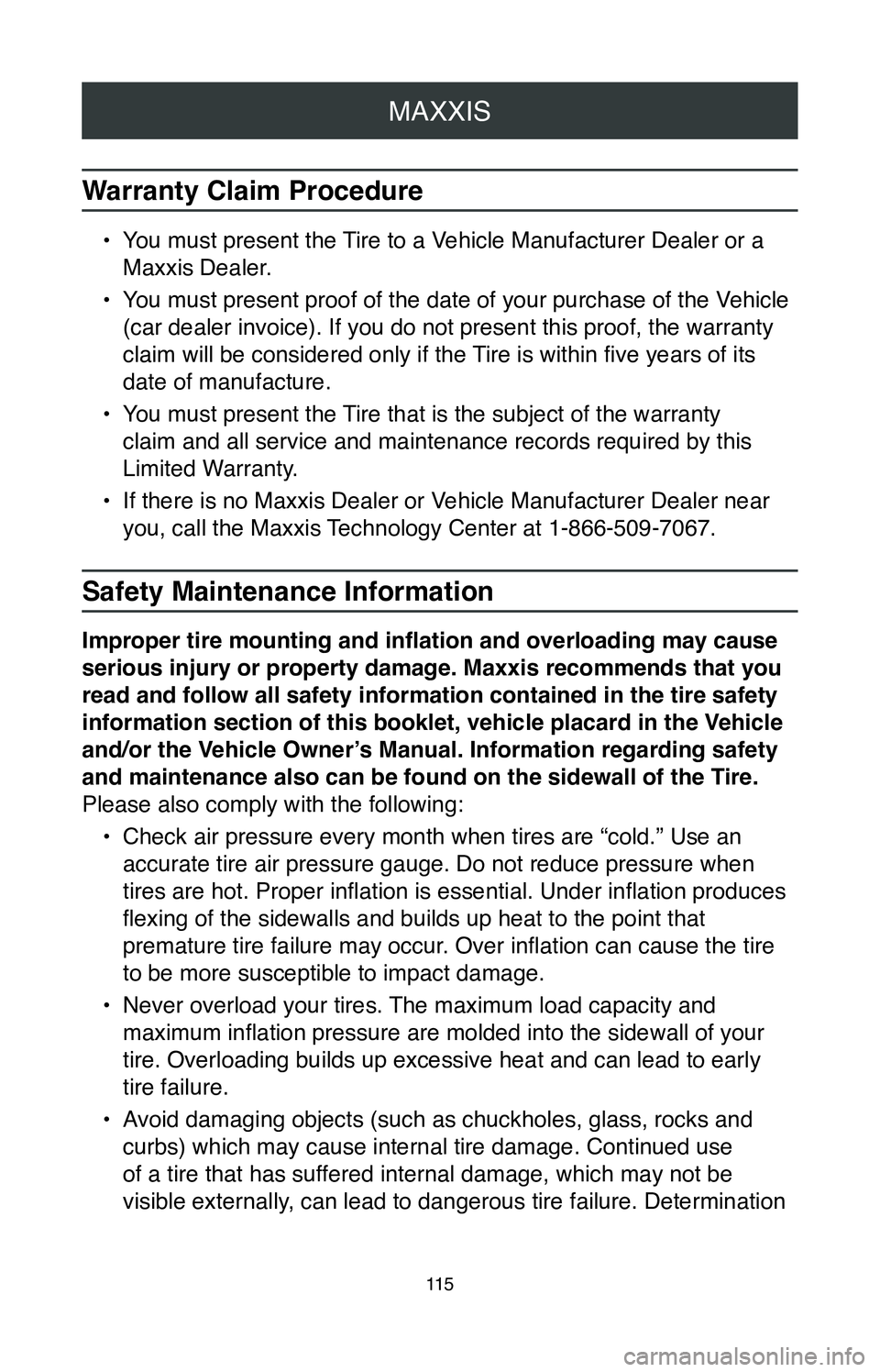
MAXXIS
11 5
Warranty Claim Procedure
• You must present the Tire to a Vehicle Manufacturer Dealer or a
Maxxis Dealer.
•
You must present proof of the date of your purchase of the Vehicle
(car dealer invoice). If you do not present this proof, the warranty
claim will be considered only if the Tire is within five years of its
date of manufacture.
•
You must present the Tire that is the subject of the warranty
claim and all service and maintenance records required by this
Limited Warranty.
•
If there is no Maxxis Dealer or Vehicle Manufacturer Dealer near
you, call the Maxxis Technology Center at 1-866-509-7067.
Safety Maintenance Information
Improper tire mounting and inflation and overloading may cause
serious injury or property damage. Maxxis recommends that you
read and follow all safety information contained in the tire safety
information section of this booklet, vehicle placard in the Vehicle
and/or the Vehicle Owner’s Manual. Information regarding safety
and maintenance also can be found on the sidewall of the Tire.
Please also comply with the following: •
Check air pressure every month when tires are “cold.” Use an
accurate tire air pressure gauge. Do not reduce pressure when
tires are hot. Proper inflation is essential. Under inflation produces
flexing of the sidewalls and builds up heat to the point that
premature tire failure may occur. Over inflation can cause the tire
to be more susceptible to impact damage.
•
Never overload your tires. The maximum load capacity and
maximum inflation pressure are molded into the sidewall of your
tire. Overloading builds up excessive heat and can lead to early
tire failure.
•
Avoid damaging objects (such as chuckholes, glass, rocks and
curbs) which may cause internal tire damage. Continued use
of a tire that has suffered internal damage, which may not be
visible externally, can lead to dangerous tire failure. Determination
Page 165 of 260

NITTO TIRE
163
Replacement tires for any vehicle must be of a size, load range, and
load capacity (by inflation) that is capable of supporting the same load
as the vehicle’s originally installed (OE) tires. Avoid installing used tires
on a vehicle. There is no way to determine what road hazards or abuse
a previously owned tire may have incurred.
The following procedures concerning replacement tires must
be followed:•
Confirm that the load-carrying capacity is greater than or equal
to the load-carrying capacity of the OE tire size at the pressure
indicated on the vehicle Tire Information Placard.
•
Carefully note any differences between recommendations for
front and rear axle positions regarding the tire size and/or
inflation pressure.
•
The speed rating must be equal to or greater than what is specified
by the vehicle manufacturer if the speed capability of the vehicle is
to be maintained.
•
Tires should be mounted on approved wheel widths. If changing
tire sizes, check to make sure the wheel has adequate load and
inflation pressure capacity.
•
Body and chassis clearance must be checked on the vehicle’s
front and rear axles.
In addition to the above, light truck tire replacements should take
into consideration the following:
Page 182 of 260
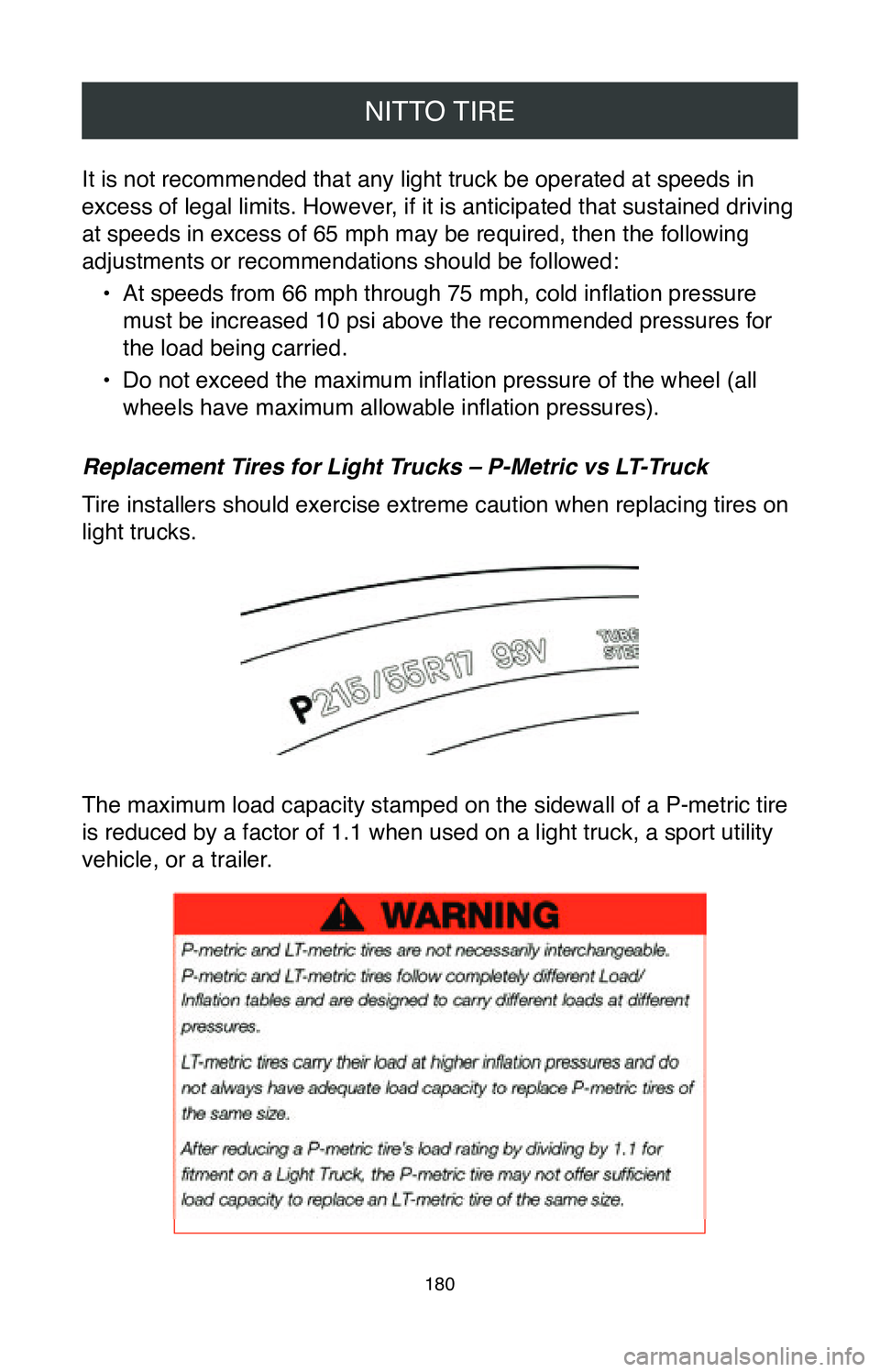
NITTO TIRE
180
It is not recommended that any light truck be operated at speeds in
excess of legal limits. However, if it is anticipated that sustained driving
at speeds in excess of 65 mph may be required, then the following
adjustments or recommendations should be followed:•
At speeds from 66 mph through 75 mph, cold inflation pressure
must be increased 10 psi above the recommended pressures for
the load being carried.
•
Do not exceed the maximum inflation pressure of the wheel (all
wheels have maximum allowable inflation pressures).
Replacement Tires for Light Trucks – P-Metric vs LT-Truck
Tire installers should exercise extreme caution when replacing tires on
light trucks.
The maximum load capacity stamped on the sidewall of a P-metric tire
is reduced by a factor of 1.1 when used on a light truck, a sport utilit\
y
vehicle, or a trailer.
Page 183 of 260
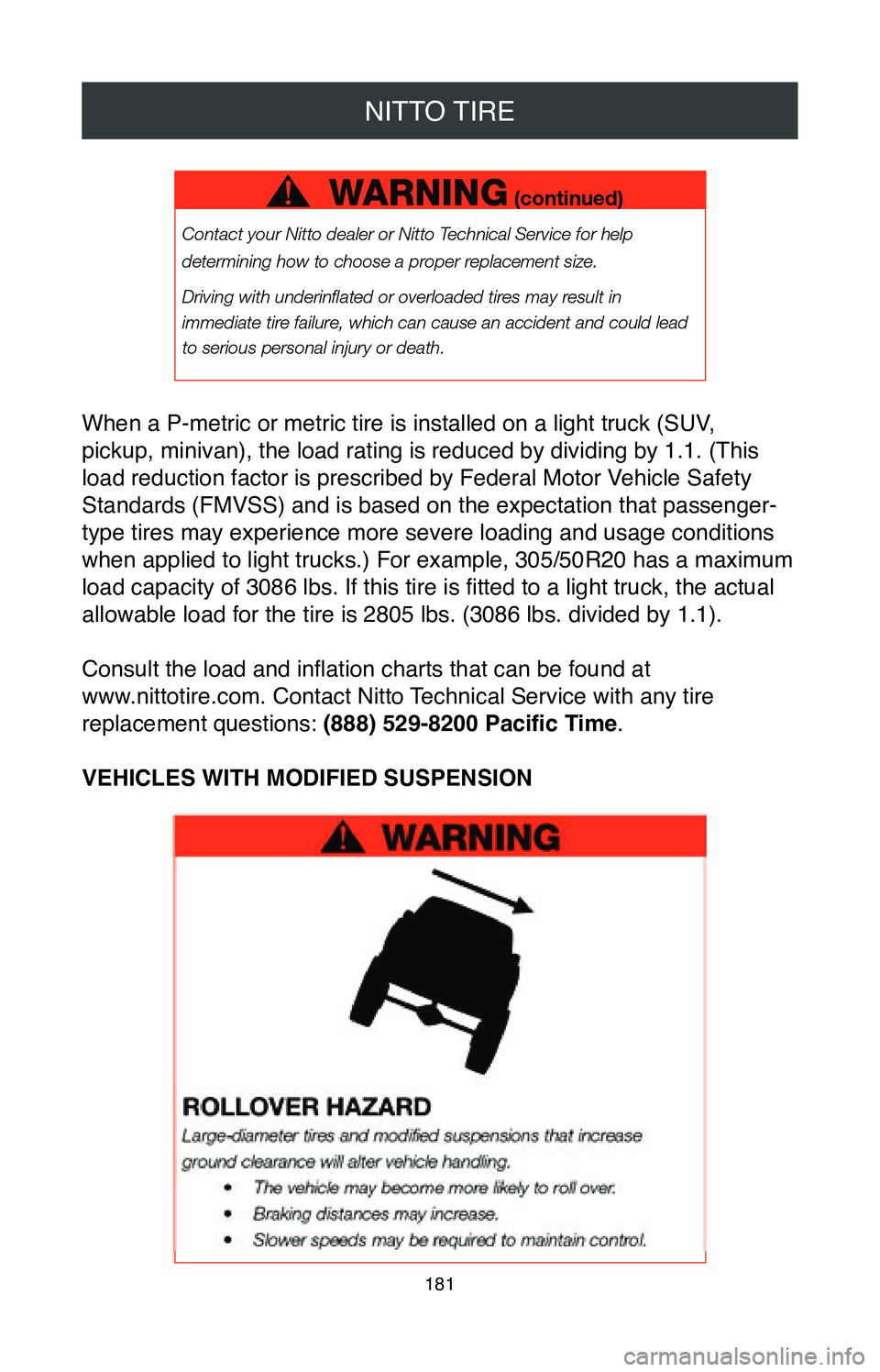
NITTO TIRE
181
When a P-metric or metric tire is installed on a light truck (SUV,
pickup, minivan), the load rating is reduced by dividing by 1.1. (This
load reduction factor is prescribed by Federal Motor Vehicle Safety
Standards (FMVSS) and is based on the expectation that passenger-
type tires may experience more severe loading and usage conditions
when applied to light trucks.) For example, 305/50R20 has a maximum
load capacity of 3086 lbs. If this tire is fitted to a light truck, the actual
allowable load for the tire is 2805 lbs. (3086 lbs. divided by 1.1).
Consult the load and inflation charts that can be found at
www.nittotire.com. Contact Nitto Technical Service with any tire
replacement questions: (888) 529-8200 Pacific Time.
VEHICLES WITH MODIFIED SUSPENSION
Page 196 of 260
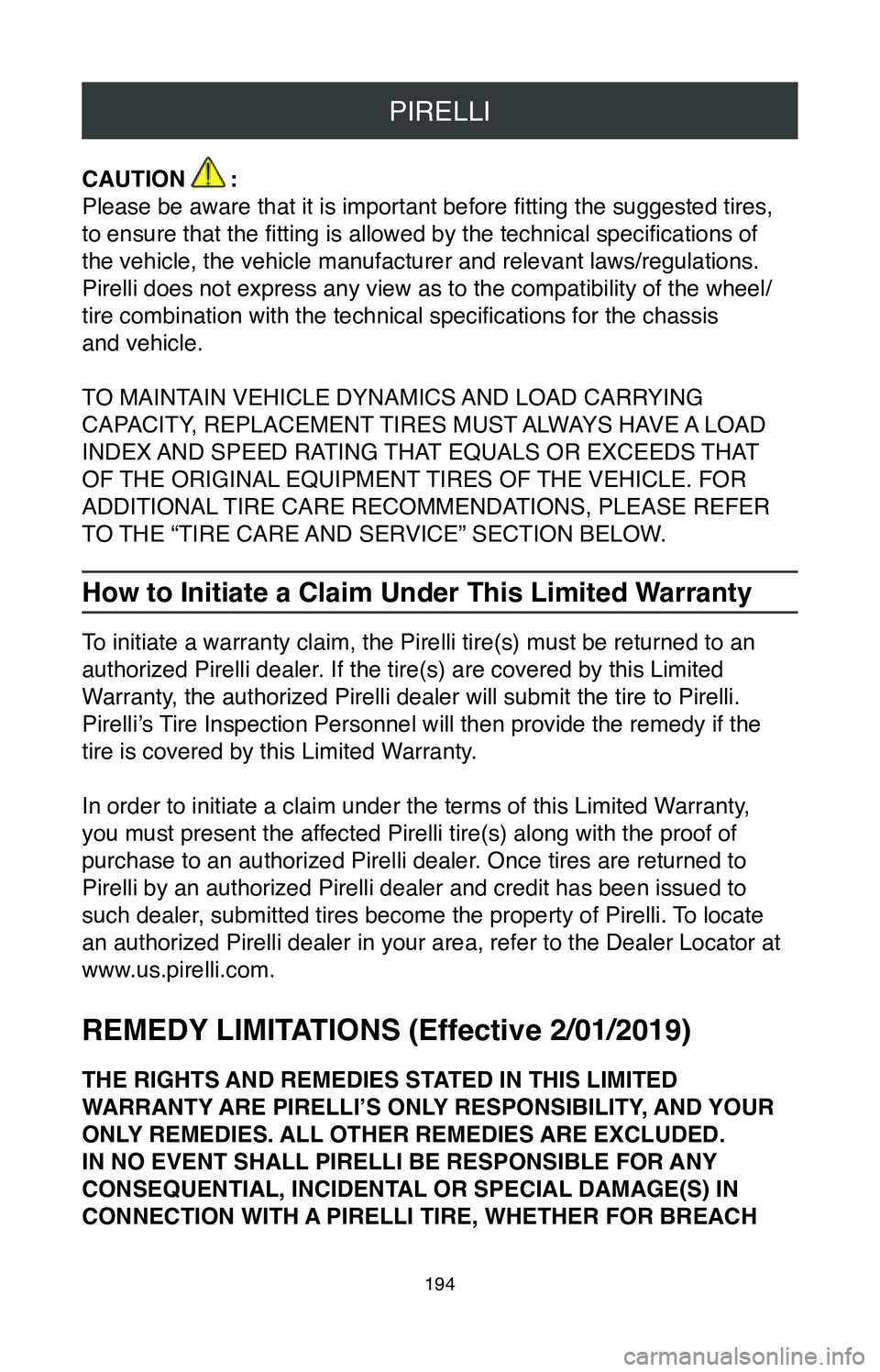
PIRELLI
194
CAUTION :
Please be aware that it is important before fitting the suggested tires,
to ensure that the fitting is allowed by the technical specifications of
the vehicle, the vehicle manufacturer and relevant laws/regulations.
Pirelli does not express any view as to the compatibility of the wheel/
tire combination with the technical specifications for the chassis
and vehicle.
TO MAINTAIN VEHICLE DYNAMICS AND LOAD CARRYING
CAPACITY, REPLACEMENT TIRES MUST ALWAYS HAVE A LOAD
INDEX AND SPEED RATING THAT EQUALS OR EXCEEDS THAT
OF THE ORIGINAL EQUIPMENT TIRES OF THE VEHICLE. FOR
ADDITIONAL TIRE CARE RECOMMENDATIONS, PLEASE REFER
TO THE “TIRE CARE AND SERVICE” SECTION BELOW.
How to Initiate a Claim Under This Limited Warranty
To initiate a warranty claim, the Pirelli tire(s) must be returned to an
authorized Pirelli dealer. If the tire(s) are covered by this Limited
Warranty, the authorized Pirelli dealer will submit the tire to Pirelli.
Pirelli’s Tire Inspection Personnel will then provide the remedy if the
tire is covered by this Limited Warranty.
In order to initiate a claim under the terms of this Limited Warranty,
you must present the affected Pirelli tire(s) along with the proof of
purchase to an authorized Pirelli dealer. Once tires are returned to
Pirelli by an authorized Pirelli dealer and credit has been issued to
such dealer, submitted tires become the property of Pirelli. To locate
an authorized Pirelli dealer in your area, refer to the Dealer Locator a\
t
www.us.pirelli.com.
REMEDY LIMITATIONS (Effective 2/01/2019)
THE RIGHTS AND REMEDIES STATED IN THIS LIMITED
WARRANTY ARE PIRELLI’S ONLY RESPONSIBILITY, AND YOUR
ONLY REMEDIES. ALL OTHER REMEDIES ARE EXCLUDED.
IN NO EVENT SHALL PIRELLI BE RESPONSIBLE FOR ANY
CONSEQUENTIAL, INCIDENTAL OR SPECIAL DAMAGE(S) IN
CONNECTION WITH A PIRELLI TIRE, WHETHER FOR BREACH
Page 199 of 260
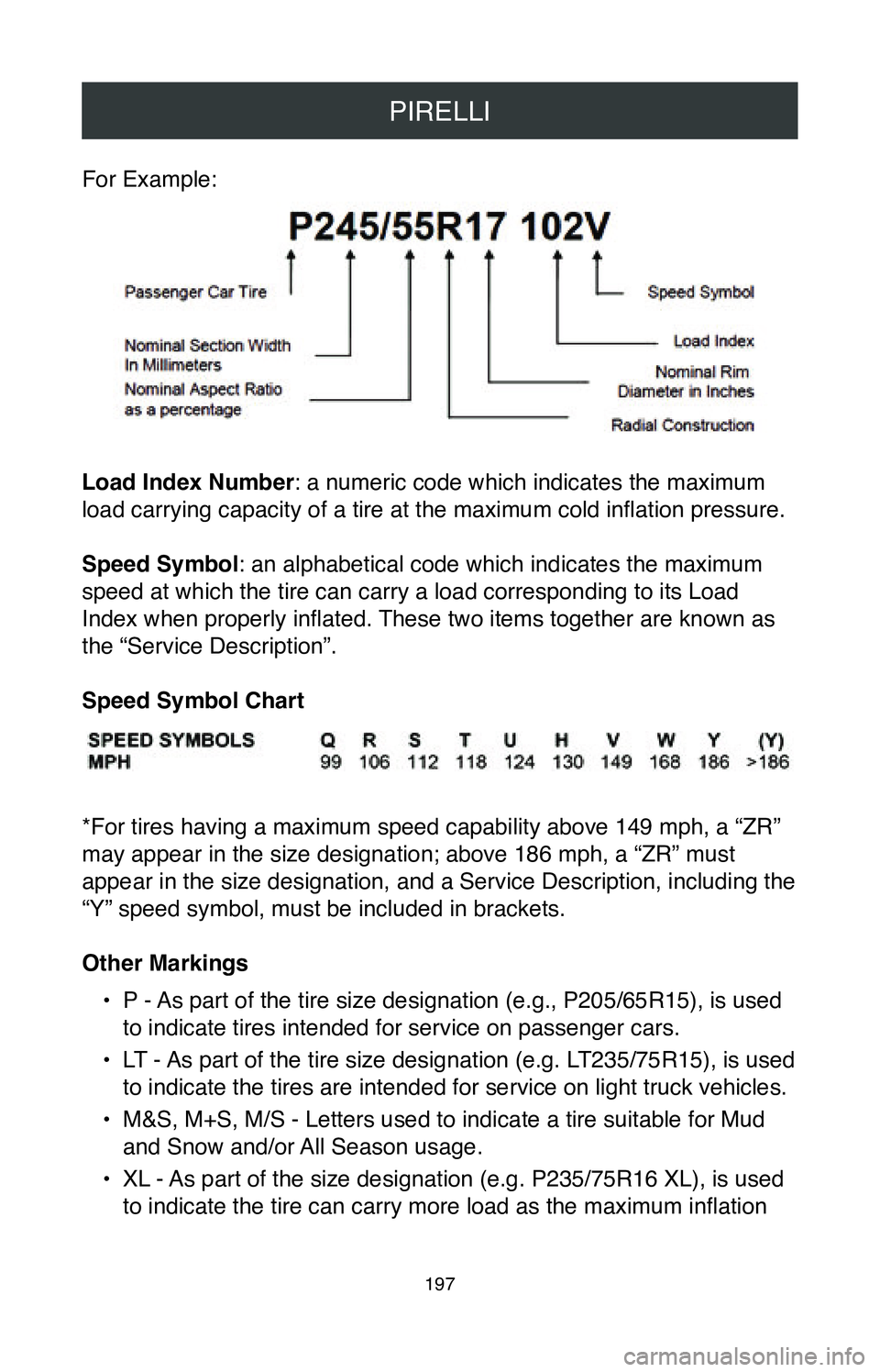
PIRELLI
197
For Example:
Load Index Number: a numeric code which indicates the maximum
load carrying capacity of a tire at the maximum cold inflation pressure.
Speed Symbol: an alphabetical code which indicates the maximum
speed at which the tire can carry a load corresponding to its Load
Index when properly inflated. These two items together are known as
the “Service Description”.
Speed Symbol Chart
*For tires having a maximum speed capability above 149 mph, a “ZR”
may appear in the size designation; above 186 mph, a “ZR” must
appear in the size designation, and a Service Description, including the\
“Y” speed symbol, must be included in brackets.
Other Markings
•
P - As part of the tire size designation (e.g., P205/65R15), is used
to indicate tires intended for service on passenger cars.
•
LT - As part of the tire size designation (e.g. LT235/75R15), is used
to indicate the tires are intended for service on light truck vehicles.
•
M&S, M+S, M/S - Letters used to indicate a tire suitable for Mud
and Snow and/or All Season usage.
•
XL - As part of the size designation (e.g. P235/75R16 XL), is used
to indicate the tire can carry more load as the maximum inflation
Page 204 of 260
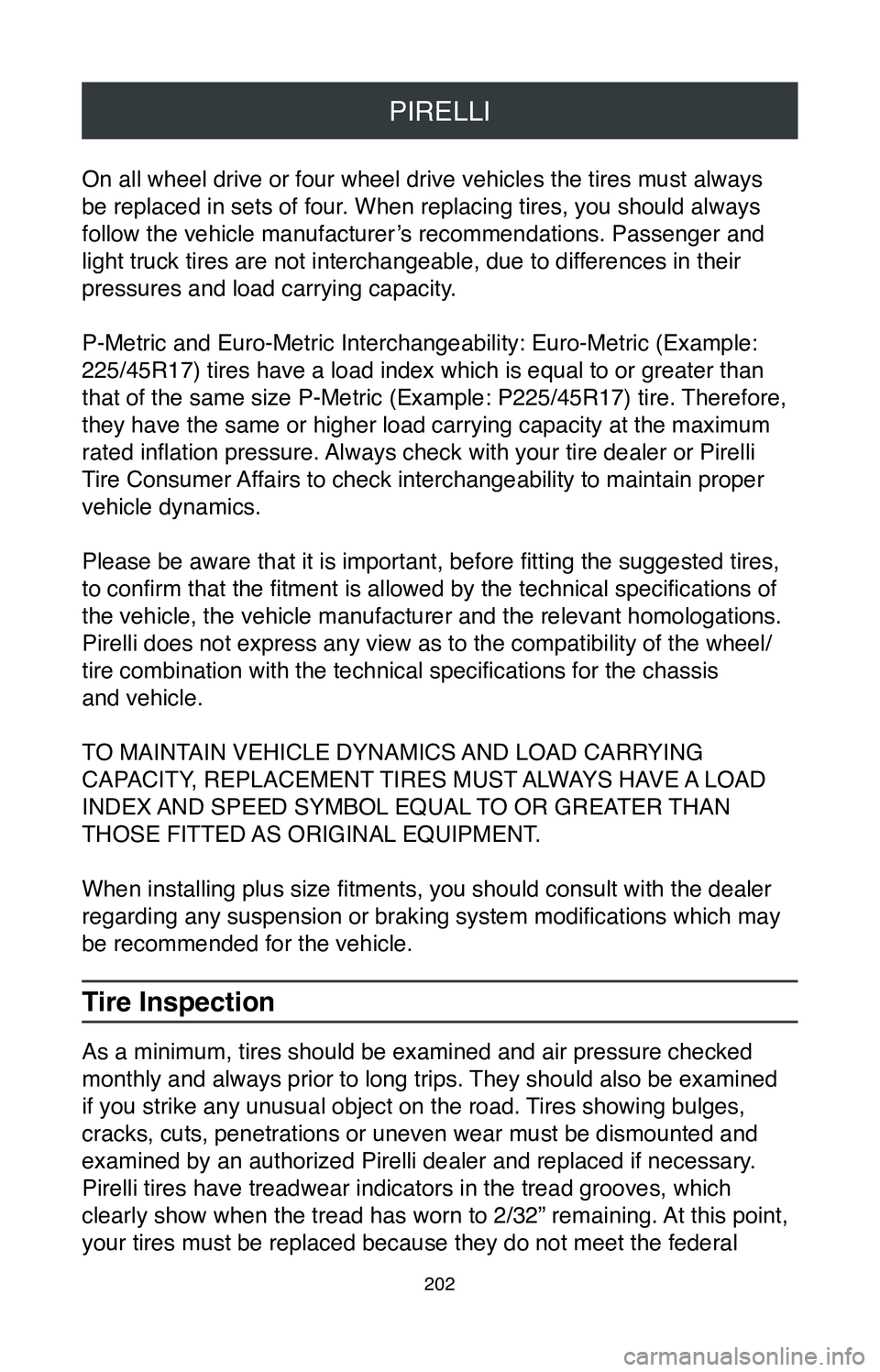
PIRELLI
202
On all wheel drive or four wheel drive vehicles the tires must always
be replaced in sets of four. When replacing tires, you should always
follow the vehicle manufacturer’s recommendations. Passenger and
light truck tires are not interchangeable, due to differences in their
pressures and load carrying capacity.
P-Metric and Euro-Metric Interchangeability: Euro-Metric (Example:
225/45R17) tires have a load index which is equal to or greater than
that of the same size P-Metric (Example: P225/45R17) tire. Therefore,
they have the same or higher load carrying capacity at the maximum
rated inflation pressure. Always check with your tire dealer or Pirelli
Tire Consumer Affairs to check interchangeability to maintain proper
vehicle dynamics.
Please be aware that it is important, before fitting the suggested tires,
to confirm that the fitment is allowed by the technical specifications of
the vehicle, the vehicle manufacturer and the relevant homologations.
Pirelli does not express any view as to the compatibility of the wheel/
tire combination with the technical specifications for the chassis
and vehicle.
TO MAINTAIN VEHICLE DYNAMICS AND LOAD CARRYING
CAPACITY, REPLACEMENT TIRES MUST ALWAYS HAVE A LOAD
INDEX AND SPEED SYMBOL EQUAL TO OR GREATER THAN
THOSE FITTED AS ORIGINAL EQUIPMENT.
When installing plus size fitments, you should consult with the dealer
regarding any suspension or braking system modifications which may
be recommended for the vehicle.
Tire Inspection
As a minimum, tires should be examined and air pressure checked
monthly and always prior to long trips. They should also be examined
if you strike any unusual object on the road. Tires showing bulges,
cracks, cuts, penetrations or uneven wear must be dismounted and
examined by an authorized Pirelli dealer and replaced if necessary.
Pirelli tires have treadwear indicators in the tread grooves, which
clearly show when the tread has worn to 2/32” remaining. At this point,
your tires must be replaced because they do not meet the federal